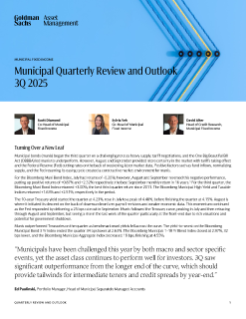Municipal Quarterly Review and Outlook 3Q 2025
Turning Over a New Leaf
Municipal bonds (munis) began the third quarter on a challenging note as heavy supply, tariff negotiations, and the One Big Beautiful Bill Act (OBBBA) led munis to underperform. However, August and September provided more certainty in the market with tariffs taking effect and the Federal Reserve (Fed) cutting rates on the back of weakening labor market data. Positive factors such as fund inflows, normalizing supply, and the Fed resuming its easing cycle created a constructive market environment for munis.
For the Bloomberg Muni Bond Index, July had returns of -0.20%; however, August and September reversed this negative performance, putting up positive returns of +0.87% and +2.32% respectively, the best September monthly return in 16 years.1 For the third quarter, the Bloomberg Muni Bond Index returned +3.00%, the best third quarter return since 2011. The Bloomberg Municipal High Yield and Taxable Indices returned +1.63% and +2.51%, respectively in the period.
The 10-year Treasury yield started the quarter at 4.23%, rose in July to a peak of 4.48%, before finishing the quarter at 4.15%. August is where it initiated its descent on the back of downward nonfarm payroll revisions and weaker economic data. This momentum continued as the Fed responded by delivering a 25 bps rate cut in September. Munis followed the Treasury curve, peaking in July and then retracing through August and September, but seeing a rise in the last week of the quarter particularly at the front-end due to rich valuations and potential for government shutdown.
Munis outperformed Treasuries on the quarter as benchmark muni yields fell across the curve. The yield-to-worst on the Bloomberg Municipal Bond 3 Yr Index ended the quarter 34 bps lower at 2.63%. The Bloomberg Municipal 1-10 Yr Blend Index closed at 2.97%, 32 bps lower, and the Bloomberg Municipal Aggregate Index decreased 19 bps, finishing at 4.55%.
Market Review
Primary Market: Normalization in Supply
The pace of new issuance slowed down for most of the quarter after initially continuing the accelerated pace we’ve seen this year. Municipal bond issuance in July was 35% higher than 12 months previously, while August was 1% lower and September was 9% lower than over the same period. Overall volume for the quarter was 7% higher than 3Q 2024 and 8% below the pace of 2Q 2025.
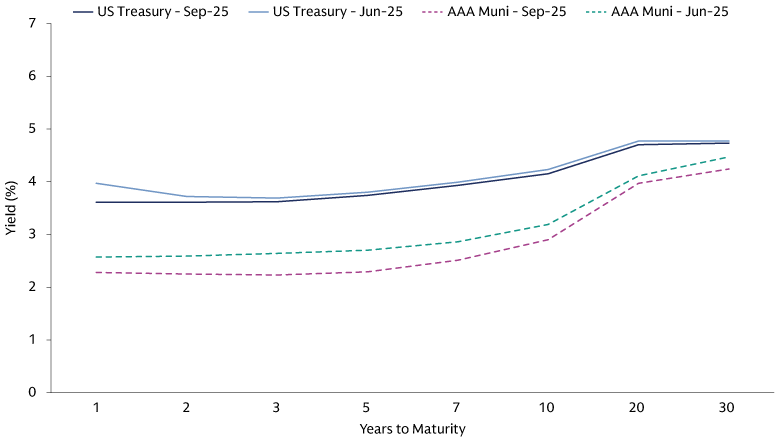
Source: Bloomberg, BVAL Muni. As of September 30, 2025.
Deals for new projects are driving new issuance volumes, while refinancing activity remains more muted. Issuers within the education, electric power, transportation, and healthcare sectors brought large deals to the market earlier in the quarter. A portion of the elevated supply may have been a result of municipalities frontloading issuance; however, these trends have started to normalize after the passage of the OBBBA as munis maintained their tax-exempt status.
Despite the initial uptick, heavy summer redemptions helped absorb the higher new issuance volumes. While forecasts are still projecting over $500 billion of new issuance this year, the normalization in the pace of deal volume should keep 2025 volume largely in line with 2024.
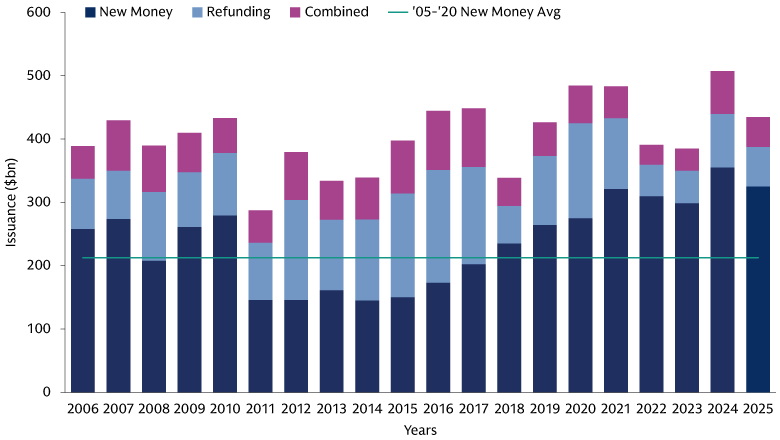
Source: Bloomberg, Bond Buyer. As of September 30, 2025.
Demand: Positive Flows
Municipal funds had solid demand, experiencing only three weeks of outflows over the quarter. September logged the second largest weekly inflow in 2025 at $2.2 billion. Investors used their summer redemptions and new investment flows to extend the duration of their portfolios given attractive valuations across the curve. In aggregate, 3Q 2025 amounted to $15 billion of inflows, a $9 billion increase of inflows compared with the previous quarter. A large portion of these inflows have gone to ETFs with a long-term duration profile.

Source: Lipper. As of September 30, 2025.
Valuation and Yield Changes: Rally Across the Curve
The Municipal AAA curve steepened to start the quarter. Front-end yields fell due to strong retail demand and long-end yields rose due to increased longer-dated supply. However, yields at the longer end of the curve eventually moved lower in August and September on weakening labor market data and increasing anticipation of a Fed rate cut.
For the quarter, AAA tax-exempt muni yields fell across the curve, decreasing 34 bps and 41 bps in 2 and 5-year tenors, and decreasing 29 bps and 19 bps in the 10 and 30-year tenors. Muni/UST ratios moved lower across the curve, decreasing an average of 7%. Ratios finished the quarter at 62/61/70/90% for 2/5/10/30-year notes respectively.
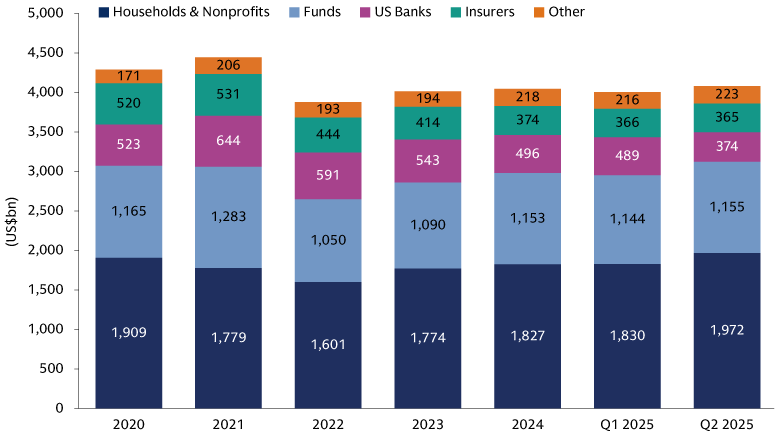
Source: Federal Reserve Board Flow of Funds data, BofA Merrill Lynch Global Research. As of 2Q25, latest available.
Yield Curve: Further Steepening
Yields decreased across the muni curve in the third quarter, with maturities of 10 years and shorter having the strongest relative performance. Thirty-year yields started the quarter with an increase; however, they declined over the rest of the quarter, finishing 23 bps lower overall. Yields of maturities 10 years and shorter decreased by 35 bps on average.
The spread between the 2- and 30-year tax-exempt muni yields increased by 12 bps, ending the quarter at 199 bps, which was down from the peak during the quarter of 240 bps. The difference between 5- and 10-year maturities steepened by 12 bps, finishing with 62 bps of steepness between those 2 nodes.
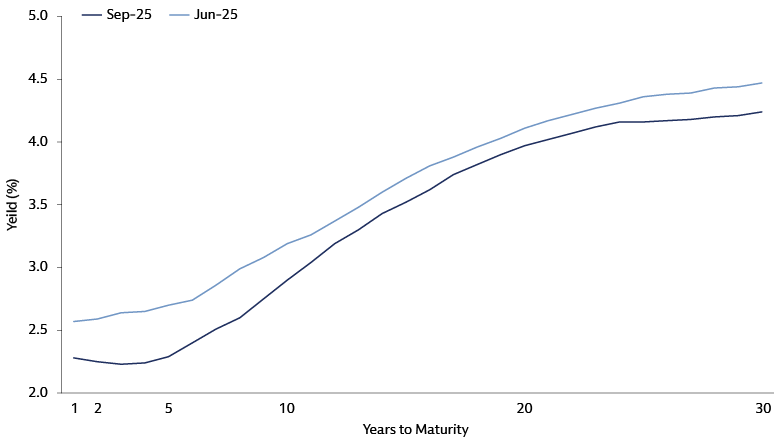
Source: BVAL Muni. As of September 30, 2025.
Investment Grade Index Returns and Spreads: Strong Positive Returns
The Bloomberg Municipal Bond Index returned +3.00% during 3Q 2025. The 1-10 Year Blend Index posted a total return of +2.33%, while the 3-year Index returned +1.52%.
Within investment grade credit, the ‘A’ segment of the municipal index recorded the highest return at +3.08%, whereas the 'BBB' segment showed the weakest performance with a return of +2.84%. From a yield curve perspective, the 22+ Year Index achieved the best performance with a return of +3.82%, while the 1-year Index experienced the lowest return at +0.99%.
BBB-AAA credit spreads widened by 9 bps to end the quarter at 106 bps. BBB-AAA credit spreads have averaged 118 bps over the last 10 years but have also reached levels as low as 54 bps back in 2021.
High Yield Municipals: Long Duration Drives Positive Return
The high yield municipal market, represented by the Bloomberg Municipal High Yield Index, posted a return of +1.63% over the quarter, underperforming the investment grade index by 137 bps―the second quarter in two years that it has underperformed IG.
Within high yield municipals, airline credits and special tax were the best performers—posting total returns of +3.14% and +3.05% for 3Q 2025 respectively. Transportation and tobacco credits were the largest underperformers, returning –7.86% and –0.74% respectively for the quarter.
Within the high yield municipal index, the 6–8 year maturity area of the curve outperformed—returning 2.60%, while the 3-year and 1-year index underperformed returning –7.56% and +1.67% respectively for the quarter.
High yield spreads increased by 17 bps during the quarter and ended September at 202 bps. High yield credit spreads have averaged 266 bps over the past ten years but also reached levels as low as 161 bps in April this year.
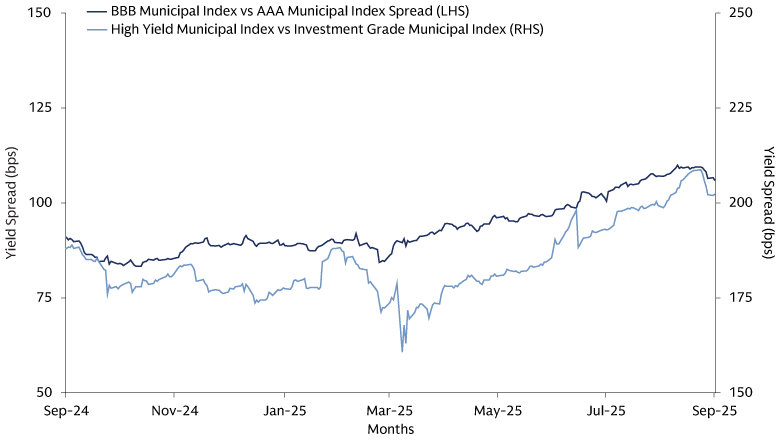
Source: BVAL Muni. As of September 30, 2025.
While some sector-wide challenges have begun to take shape, we continue to believe most distressed situations will remain one-off given the idiosyncratic nature of municipal credit. The transportation sector materially underperformed in the third quarter, returning –7.86%. Performance in that sector was driven by negative headlines from Brightline Trains Florida, leading to spread widening across the various Brightline-related credits. Underlying municipal credit quality remains solid across many sub-sectors and obligors, providing a strong fundamental base for the market.
Taxable Municipal Market: Falling Yields Drive Positive Returns
The taxable municipal market, as represented by the Bloomberg Taxable Muni Index, posted a total return of +2.51% during 3Q 2025, underperforming the tax-exempt investment grade index by 49 bps. The fall in Treasury yields during the quarter was the main driver of the positive return. Taxable muni issuance was 31% lower than over the same quarter in 2024, and 42% lower than the second quarter of 2025.
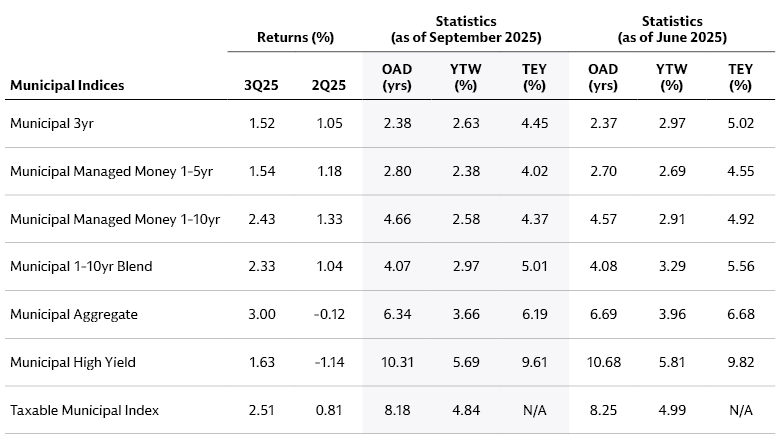
Source: Bloomberg, Goldman Sachs Asset Management, Barclays. As of September 30, 2025.
OAD: “Option adjusted duration” is a measure of the sensitivity of a bond's price to interest rate changes, assuming that the expected cash flows of the bond may change with interest rates. YTW: “Yield to worst” is calculated by making worst-case scenario assumptions (excluding issuer default) on the bond by calculating the returns that would be received if provisions, including prepayment, call, put, and sinking fund, are used by the issuer. YTW may be the same as YTM, but never higher. YTW does not represent the performance yield for the Fund. TEY: “Taxable equivalent yield” is the return that is required on a taxable investment to make it equal to the return on a tax-exempt investment. Past performance does not predict future returns and does not guarantee future results, which may vary. Goldman Sachs does not provide accounting, tax or legal advice. Please see additional disclosures at the end of this document. Past correlations are not indicative of future correlations, which may vary. Returns less than 12 months are cumulative, not annualized.
Municipal Credit Update
Federal Government Shutdown to Have Limited Impact on Munis
Following the U.S. Senate’s failure to pass a continuing resolution on 30 September, the federal government shut down with only essential employees continuing to work. Prior shutdowns, the longest of which was 35 days (2018-19), have had a limited effect on municipal bonds. We do not expect any material impact from the current shutdown.
States and most local governments receive federal funding with varying levels of importance to day-to-day operations. Most federal funding is non-discretionary (notably entitlement programs and debt service) and will continue to flow during the shutdown, leaving this key revenue source for municipal issuers unaffected. In addition, states maintain additional payment guarantees and set-asides for bonds backed by federal appropriations that could see a temporary delay in payments.
A prolonged government shutdown has the potential to impact economic growth, particularly in areas that have a larger federal workforce or significant government contracting. We continue to monitor the budget and economic disclosures of individual states and local governments for any knock-on effects of the shutdown.
High-Profile Issuers Receive Upgrades
The ratio of rating agency upgrades to downgrades improved in the third quarter of 2025 after slowing through the first half of the year. The combined upgrade-to-downgrade ratio for Moody’s and S&P remains positive for the year at 1.5x, up from 1.1x through the first two quarters. While the number of Moody’s upgrades and downgrades were relatively balanced in the third quarter, S&P issued more than four times more upgrades than downgrades in the quarter.
Notable upgrades this quarter included the states of Connecticut (Moody’s Aa2/S&P AA-/Fitch AA) and New Jersey (Moody’s Aa3/S&P A+/Fitch A+); both states received upgrades from multiple rating agencies driven by enhanced fiscal discipline that has improved reserve levels while simultaneously working to reduce debt and pension liabilities. In addition, S&P upgraded the New York Metropolitan Transportation Authority to A from A-, citing continuing demonstration of strong state support, ongoing recovery in ridership, healthy liquidity, and manageable projected deficits in future years. These favorable rating outcomes underscore the improved resiliency of municipal issuers in recent years which have benefited from reserves at or near all-time highs.
Municipal Bond Default Update Through 3Q
The par amount of first-time municipal bond defaults declined 20% year-over-year through the first three quarters of 2025. Proton therapy, project finance and senior living bonds still accounted for most first-time defaults (as measured by par) in 2025, making up 70% collectively which is in line with last year’s percentage.
The above numbers do not factor in the two Brightline Florida passenger rail CUSIPs totaling $1.2 billion that were subjected to payment deferrals in July 2025 as the company was within its legal right to not make its July 1 interest payment.
Pension Update: Funding Ratios Improve
The aggregate funded ratio for state and local pension plans increased from 78.3% at the end of fiscal year 2024 to 81.4% in fiscal year 2025, according to a report by the Equable Institute (as of July 15, 2025). This would mark the third consecutive year of improvement and the second highest aggregate funded ratio since 2006.
The report highlights the progress made by state and local governments in addressing their pension liabilities in recent years by increasing annual contributions to their defined benefit pension plans. The number of state pension plans that received less than 100% of their actuarially required contribution has declined to 18% from 33% over the past 10 years. In addition, strong investment returns have also helped funded ratios in recent years, with rolling 10-year actual investment returns exceeding assumed return rates for the past seven years.
State and local governments have made considerable strides in addressing their unfunded pension obligations. However, their path forward remains subject to market risk and political considerations. We believe that issuers will be required to balance rising pension contribution requirements with inflationary pressures and a more uncertain revenue environment in future years.
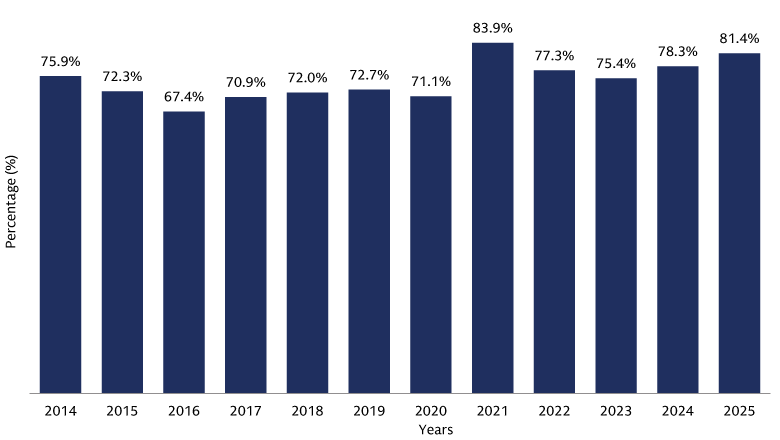
Sources: Equable Institute, Goldman Sachs Asset Management. As of July 15, 2025.
Notable Mentions and Market Movers
- OBBBA signed into law on 4 July
- The FOMC leaves the target rate for the federal funds unchanged at 4.25-4.50%
- Brightline defers its interest payment
- Fresh tariffs take effect on 7 August Nonfarm payrolls revised down 258,000 cumulatively across May and June
- Fourth largest tax-exempt muni issuance week in history
- FOMC cuts rates by 25 bps
- Nonfarm payrolls revised down 911,000 for the previous 12 months, largest revision since 2000
- Munis post best two-week return for 2025
Municipal Market Outlook
Supply/Demand
Primary market supply, one of the major headwinds for the municipal market over the past 18 months, will continue to be a factor over the next quarter. However, we believe that volumes will likely slow relative to the torrid pace we have witnessed during the first three quarters of this year, as issuer concerns about losing their ability to borrow in the tax-exempt markets have dissipated now that the OBBBA has been signed into law. As we enter the fall, we expect demand to stay consistent across investment vehicles―SMAs, Mutual Funds and ETFs―as investors and clients seek to extend their duration as the Fed enters an easing cycle. We expect municipals to perform well over the next quarter given the expected normalization of supply and continued strong demand.
Valuations
Intermediate and longer-dated yields present a compelling entry point for municipal bonds, as tax-equivalent yields in these parts of the curve are attractive for many investors. This is further supported by the steepness of the muni yield curve, which is 91 bps steeper than the Treasury yield curve.
Credit/Spreads
We believe income will be the main driver of returns in the near term, overcoming perceived challenges in the wider market. The recent US government shutdown has rekindled investment concerns; however historically shutdowns have not had a meaningful effect on municipal bonds. We continue to find opportunities in the high yield market, view credit at current spreads to be additive to portfolios and are focused on active credit selection to take advantage of our opportunity set.
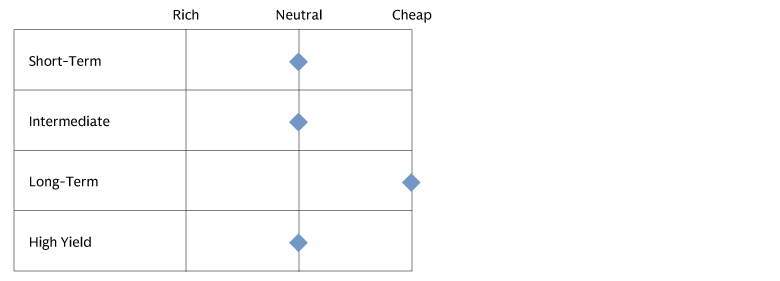
1Source: Bloomberg, As of September 30, 2025
